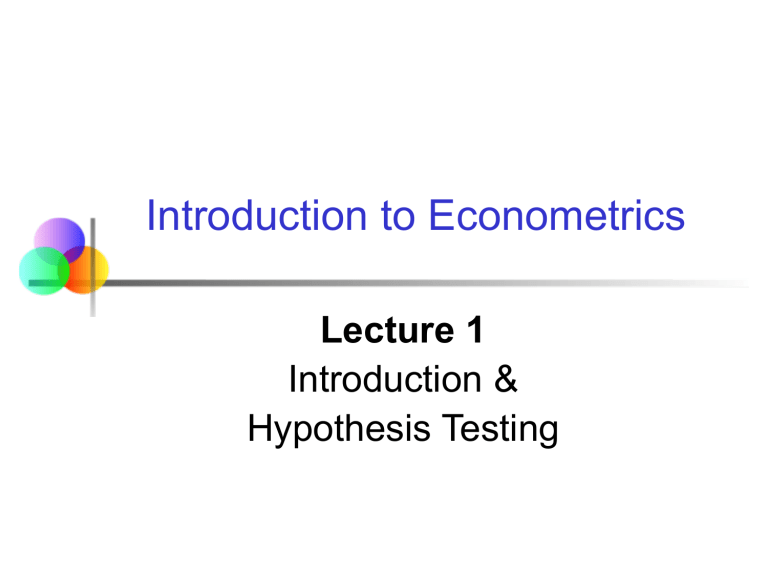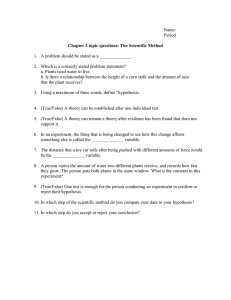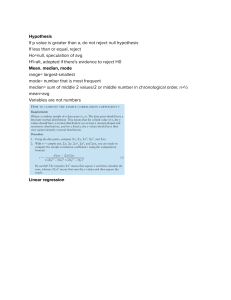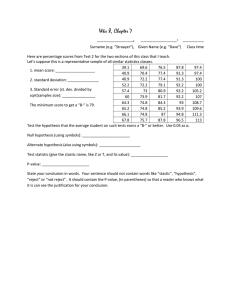
Introduction to Econometrics Lecture 1 Introduction & Hypothesis Testing Introduction Assessment: What is econometrics? “Econometrics is what econometricians do.” “Econometrics is the study of the application of statistical methods to the analysis of economic phenomena.” (Tintner, 1953). The modern era of econometrics, as we know it today, started in the 1940's. Klein (1971) attributes the formulation of the econometrics problem in terms of the theory of statistical inference to Haavelmo (1943, 1944) and Mann and Wald (1943). Historically speaking... Ragnar Frisch Frisch was one of the founders of the Econometric Society in 1930, and edited the journal Econometrica for its first 21 years. Alma mater University of Oslo Known for Econometrics Production theory Awards Nobel Memorial Prize in Economic Sciences (1969) Chapter Goals After completing this chapter, you should be able to: Formulate null and alternative hypotheses for applications involving a single population mean from a normal distribution a single population proportion (large samples) Formulate a decision rule for testing a hypothesis Know how to use the critical value and p-value approaches to test the null hypothesis (for both mean and proportion problems) Know what Type I and Type II errors are Assess the power of a test What is a Hypothesis? A hypothesis is a claim (assumption) about a population parameter: population mean Example: The mean monthly cell phone bill of this city is μ = $42 population proportion Example: The proportion of adults in this city with cell phones is p = .68 The Null Hypothesis, H0 States the assumption (numerical) to be tested Example: The average number of TV sets in U.S. Homes is equal to three ( H0 : μ 3 ) Is always about a population parameter, not about a sample statistic H0 : μ 3 H0 : X 3 The Null Hypothesis, H0 (continued) Begin with the assumption that the null hypothesis is true Similar to the notion of innocent until proven guilty Refers to the status quo Always contains “=” , “≤” or “” sign May or may not be rejected The Alternative Hypothesis, H1 Is the opposite of the null hypothesis e.g., The average number of TV sets in U.S. homes is not equal to 3 ( H1: μ ≠ 3 ) Challenges the status quo Never contains the “=” , “≤” or “” sign May or may not be supported Is generally the hypothesis that the researcher is trying to support Hypothesis Testing Process Claim: the population mean age is 50. (Null Hypothesis: H0: μ = 50 ) Population Is X 20 likely if μ = 50? If not likely, REJECT Null Hypothesis Suppose the sample mean age is 20: X = 20 Now select a random sample Sample Reason for Rejecting H0 Sampling Distribution of X 20 If it is unlikely that we would get a sample mean of this value ... μ = 50 If H0 is true ... if in fact this were the population mean… X ... then we reject the null hypothesis that μ = 50. Level of Significance, Defines the unlikely values of the sample statistic if the null hypothesis is true Defines rejection region of the sampling distribution Is designated by , (level of significance) Typical values are .01, .05, or .10 Is selected by the researcher at the beginning Provides the critical value(s) of the test Level of Significance and the Rejection Region Level of significance = H0: μ = 3 H1: μ ≠ 3 /2 Two-tail test /2 Upper-tail test H0: μ ≥ 3 H1: μ < 3 Rejection region is shaded 0 H0: μ ≤ 3 H1: μ > 3 0 Lower-tail test 0 Represents critical value Errors in Making Decisions Type I Error Reject a true null hypothesis Considered a serious type of error The probability of Type I Error is Called level of significance of the test Set by researcher in advance Errors in Making Decisions (continued) Type II Error Fail to reject a false null hypothesis The probability of Type II Error is β Outcomes and Probabilities Possible Hypothesis Test Outcomes Actual Situation Key: Outcome (Probability) Decision H0 True H0 False Do Not Reject H0 No error (1 - ) Type II Error (β) Reject H0 Type I Error () No Error (1-β) Type I & II Error Relationship Type I and Type II errors can not happen at the same time Type I error can only occur if H0 is true Type II error can only occur if H0 is false If Type I error probability ( ) Type II error probability ( β ) , then Factors Affecting Type II Error All else equal, β when the difference between hypothesized parameter and its true value β when β when σ β when n Power of the Test The power of a test is the probability of rejecting a null hypothesis that is false i.e., Power = P(Reject H0 | H1 is true) Power of the test increases as the sample size increases Hypothesis Tests for the Mean Hypothesis Tests for Known Unknown Test of Hypothesis for the Mean (σ Known) Convert sample result ( x ) to a z value Hypothesis Tests for σ Known σ Unknown Consider the test H0 : μ μ0 The decision rule is: x μ0 Reject H0 if z zα σ (Assume the population is normal) n H1 : μ μ0 Decision Rule x μ0 Reject H0 if z zα σ n H0: μ = μ0 H1: μ > μ0 Alternate rule: Reject H 0 if X μ0 Z α σ/ n Z x Do not reject H0 0 μ0 zα μ0 z α Reject H0 σ n Critical value p-Value Approach to Testing p-value: Probability of obtaining a test statistic more extreme ( ≤ or ) than the observed sample value given H0 is true Also called observed level of significance Smallest value of for which H0 can be rejected p-Value Approach to Testing (continued) Convert sample result (e.g., x ) to test statistic (e.g., z statistic ) Obtain the p-value x - μ0 p - value P(Z , given that H0 is true) For an upper σ/ n tail test: P(Z x - μ0 | μ μ0 ) σ/ n Decision rule: compare the p-value to If p-value < , reject H0 If p-value , do not reject H0 Example: Upper-Tail Z Test for Mean ( Known) A phone industry manager thinks that customer monthly cell phone bill have increased, and now average over $52 per month. The company wishes to test this claim. (Assume = 10 is known) Form hypothesis test: H0: μ ≤ 52 the average is not over $52 per month H1: μ > 52 the average is greater than $52 per month (i.e., sufficient evidence exists to support the manager’s claim) Example: Find Rejection Region (continued) Suppose that = .10 is chosen for this test Find the rejection region: Reject H0 = .10 Do not reject H0 0 1.28 Reject H0 x μ0 Reject H0 if z 1.28 σ/ n Example: Sample Results (continued) Obtain sample and compute the test statistic Suppose a sample is taken with the following results: n = 64, x = 53.1 (=10 was assumed known) Using the sample results, x μ0 53.1 52 z 0.88 σ 10 n 64 Example: Decision (continued) Reach a decision and interpret the result: Reject H0 = .10 Do not reject H0 1.28 0 z = 0.88 Reject H0 Do not reject H0 since z = 0.88 < 1.28 i.e.: there is not sufficient evidence that the mean bill is over $52 Example: p-Value Solution Calculate the p-value and compare to (continued) (assuming that μ = 52.0) p-value = .1894 Reject H0 = .10 P(x 53.1 | μ 52.0) 53.1 52.0 P z 10/ 64 0 Do not reject H0 1.28 Z = .88 Reject H0 P(z 0.88) 1 .8106 .1894 Do not reject H0 since p-value = .1894 > = .10 One-Tail Tests In many cases, the alternative hypothesis focuses on one particular direction H0: μ ≤ 3 H1: μ > 3 H0: μ ≥ 3 H1: μ < 3 This is an upper-tail test since the alternative hypothesis is focused on the upper tail above the mean of 3 This is a lower-tail test since the alternative hypothesis is focused on the lower tail below the mean of 3 Upper-Tail Tests There is only one critical value, since the rejection area is in only one tail H0: μ ≤ 3 H1: μ > 3 Do not reject H0 Z 0 x μ zα Reject H0 Critical value Lower-Tail Tests H0: μ ≥ 3 There is only one critical value, since the rejection area is in only one tail H1: μ < 3 Reject H0 -z Do not reject H0 Critical value 0 Z μ x Two-Tail Tests In some settings, the alternative hypothesis does not specify a unique direction There are two critical values, defining the two regions of rejection H0: μ = 3 H1: μ 3 /2 /2 x 3 Reject H0 Do not reject H0 -z/2 Lower critical value 0 Reject H0 +z/2 z Upper critical value Hypothesis Testing Example Test the claim that the true mean # of TV sets in US homes is equal to 3. (Assume σ = 0.8) State the appropriate null and alternative hypotheses H0: μ = 3 , H1: μ ≠ 3 (This is a two tailed test) Specify the desired level of significance Suppose that = .05 is chosen for this test Choose a sample size Suppose a sample of size n = 100 is selected Hypothesis Testing Example (continued) Determine the appropriate technique σ is known so this is a z test Set up the critical values For = .05 the critical z values are ±1.96 Collect the data and compute the test statistic Suppose the sample results are n = 100, x = 2.84 (σ = 0.8 is assumed known) So the test statistic is: z X μ0 2.84 3 .16 2.0 σ 0.8 .08 n 100 Hypothesis Testing Example (continued) Is the test statistic in the rejection region? Reject H0 if z < -1.96 or z > 1.96; otherwise do not reject H0 = .05/2 Reject H0 -z = -1.96 = .05/2 Do not reject H0 0 Reject H0 +z = +1.96 Here, z = -2.0 < -1.96, so the test statistic is in the rejection region Hypothesis Testing Example (continued) Reach a decision and interpret the result = .05/2 Reject H0 -z = -1.96 = .05/2 Do not reject H0 0 Reject H0 +z = +1.96 -2.0 Since z = -2.0 < -1.96, we reject the null hypothesis and conclude that there is sufficient evidence that the mean number of TVs in US homes is not equal to 3 Example: p-Value Example: How likely is it to see a sample mean of 2.84 (or something further from the mean, in either direction) if the true mean is = 3.0? x = 2.84 is translated to a z score of z = -2.0 P(z 2.0) .0228 /2 = .025 P(z 2.0) .0228 .0228 /2 = .025 .0228 p-value = .0228 + .0228 = .0456 -1.96 -2.0 0 1.96 2.0 Z Example: p-Value Compare the p-value with If p-value < , reject H0 If p-value , do not reject H0 Here: p-value = .0456 = .05 Since .0456 < .05, we reject the null hypothesis /2 = .025 (continued) /2 = .025 .0228 .0228 -1.96 -2.0 0 1.96 2.0 Z t Test of Hypothesis for the Mean (σ Unknown) Convert sample result ( x ) to a t test statistic Hypothesis Tests for σ Known σ Unknown Consider the test H0 : μ μ0 The decision rule is: x μ0 Reject H0 if t t n-1, α H1 : μ μ0 s n (Assume the population is normal) t Test of Hypothesis for the Mean (σ Unknown) (continued) For a two-tailed test: Consider the test H0 : μ μ0 H1 : μ μ0 (Assume the population is normal, and the population variance is unknown) The decision rule is: Reject H0 if t x μ0 x μ0 t n-1, α/2 or if t t n-1, α/2 s s n n Example: Two-Tail Test ( Unknown) The average cost of a hotel room in New York is said to be $168 per night. A random sample of 25 hotels resulted in x = $172.50 and s = $15.40. Test at the = 0.05 level. (Assume the population distribution is normal) H0: μ = 168 H1: μ 168 Example Solution: Two-Tail Test H0: μ = 168 H1: μ 168 = 0.05 /2=.025 Reject H0 -t n-1,α/2 -2.0639 n = 25 is unknown, so use a t statistic Critical Value: t24 , .025 = ± 2.0639 t n 1 /2=.025 Do not reject H0 0 1.46 Reject H0 t n-1,α/2 2.0639 x μ 172.50 168 1.46 s 15.40 n 25 Do not reject H0: not sufficient evidence that true mean cost is different than $168 Tests of the Population Proportion Involves categorical variables Two possible outcomes “Success” (a certain characteristic is present) “Failure” (the characteristic is not present) Fraction or proportion of the population in the “success” category is denoted by P Assume sample size is large Proportions (continued) Sample proportion in the success category is denoted by p̂ ˆp x number of successes in sample n sample size When nP(1 – P) > 9, p̂ can be approximated by a normal distribution with mean and standard deviation P(1 P) μp̂ P σ p̂ n Hypothesis Tests for Proportions The sampling distribution of p̂ is Hypothesis approximately Tests for P normal, so the test statistic is a z nP(1 – P) < 9 nP(1 – P) > 9 value: z pˆ P0 P0 (1 P0 ) n Not discussed in this chapter Example: Z Test for Proportion A marketing company claims that it receives 8% responses from its mailing. To test this claim, a random sample of 500 were surveyed with 25 responses. Test at the = .05 significance level. Check: Our approximation for P is p̂ = 25/500 = .05 nP(1 - P) = (500)(.05)(.95) = 23.75 > 9 Z Test for Proportion: Solution Test Statistic: H0: P = .08 H1: P .08 = .05 n = 500, p̂ z = .05 Decision: Critical Values: ± 1.96 Reject pˆ P0 .05 .08 2.47 P0 (1 P0 ) .08(1 .08) 500 n Reject Reject H0 at = .05 Conclusion: .025 .025 -1.96 -2.47 0 1.96 z There is sufficient evidence to reject the company’s claim of 8% response rate. p-Value Solution (continued) Calculate the p-value and compare to (For a two sided test the p-value is always two sided) Do not reject H0 Reject H0 /2 = .025 Reject H0 p-value = .0136: /2 = .025 P(Z 2.47) P(Z 2.47) .0068 .0068 -1.96 Z = -2.47 0 2(.0068) 0.0136 1.96 Z = 2.47 Reject H0 since p-value = .0136 < = .05 Power of the Test Recall the possible hypothesis test outcomes: Actual Situation Key: Outcome (Probability) Decision H0 True H0 False Do Not Reject H0 No error (1 - ) Type II Error (β) Reject H0 Type I Error ( ) No Error (1-β) β denotes the probability of Type II Error 1 – β is defined as the power of the test Power = 1 – β = the probability that a false null hypothesis is rejected Type II Error Assume the population is normal and the population variance is known. Consider the test H0 : μ μ0 H1 : μ μ0 The decision rule is: x μ0 Reject H0 if z z α or Reject H 0 if x x c μ0 Z α σ/ n σ/ n If the null hypothesis is false and the true mean is μ*, then the probability of type II error is xc μ * β P(x x c | μ μ*) P z σ / n Type II Error Example Type II error is the probability of failing to reject a false H0 Suppose we fail to reject H0: μ 52 when in fact the true xc mean is μ* = 50 50 Reject H0: μ 52 52 xc Do not reject H0 : μ 52 Type II Error Example (continued) Suppose we do not reject H0: μ 52 when in fact the true mean is μ* = 50 This is the range of x where H0 is not rejected This is the true distribution of x if μ = 50 50 52 Reject H0: μ 52 Do not reject H0 : μ 52 xc Type II Error Example (continued) Suppose we do not reject H0: μ 52 when in fact the true mean is μ* = 50 Here, β = P( x x c ) if μ* = 50 β 50 52 Reject H0: μ 52 Do not reject H0 : μ 52 xc Calculating β Suppose n = 64 , σ = 6 , and = .05 σ 6 x c μ0 z α 52 1.645 50.766 n 64 (for H0 : μ 52) So β = P( x 50.766 ) if μ* = 50 50 50.766 Reject H0: μ 52 xc 52 Do not reject H0 : μ 52 Calculating β (continued) Suppose n = 64 , σ = 6 , and = .05 50.766 50 P( x 50.766 | μ* 50) P z P(z 1.02) .5 .3461 .1539 6 64 Probability of type II error: β = .1539 50 52 Reject H0: μ 52 Do not reject H0 : μ 52 xc Power of the Test Example If the true mean is μ* = 50, The probability of Type II Error = β = 0.1539 The power of the test = 1 – β = 1 – 0.1539 = 0.8461 Actual Situation Key: Outcome (Probability) Decision H0 True Do Not Reject H0 No error 1 - = 0.95 Reject H0 Type I Error = 0.05 H0 False Type II Error β = 0.1539 No Error 1 - β = 0.8461 (The value of β and the power will be different for each μ*) Chapter Summary Addressed hypothesis testing methodology Performed Z Test for the mean (σ known) Discussed critical value and p-value approaches to hypothesis testing Performed one-tail and two-tail tests Performed t test for the mean (σ unknown) Performed Z test for the proportion Discussed type II error and power of the test




